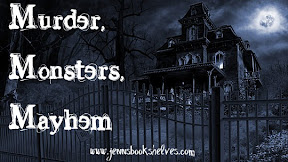Today I’m pleased to welcome Chelsea Quinn Yarbro, Bram Stoker Lifetime Achievement Award winner and supernatural fiction author to guest post today! Chelsea’s topic is an appropriate one for Murder, Monsters & Mayhem: the lore behind monsters!
Monsters: Omission and Commission by Chelsea Quinn Yarbro
 Monsters are part of the human condition; the whole tradition that has become the lore of monsters reveals that humans and monsters are frequently two sides of the same coins, and never more so than in the wonderful tradition of horror literature. Folklore is full of all manner of monsters, some mostly human, some mostly not, some victims of fate, some actively seeking out the monstrous. There are internalized monsters — witches, warlocks, magicians, vampires, and some shamans, among others — and there are externalized monsters — dragons, gryphons, shape-shifters, trolls, cyclopeses, furies, demons, ghouls, and some angels, among others — and each of them expresses the monstrous in a different manner. The creature-monsters are the more obviously frightening, because of their obvious otherness; the human-monster are the more sinister, because they have no obvious identification to alert humans of the monster in their midst.
Monsters are part of the human condition; the whole tradition that has become the lore of monsters reveals that humans and monsters are frequently two sides of the same coins, and never more so than in the wonderful tradition of horror literature. Folklore is full of all manner of monsters, some mostly human, some mostly not, some victims of fate, some actively seeking out the monstrous. There are internalized monsters — witches, warlocks, magicians, vampires, and some shamans, among others — and there are externalized monsters — dragons, gryphons, shape-shifters, trolls, cyclopeses, furies, demons, ghouls, and some angels, among others — and each of them expresses the monstrous in a different manner. The creature-monsters are the more obviously frightening, because of their obvious otherness; the human-monster are the more sinister, because they have no obvious identification to alert humans of the monster in their midst.
Jungian psychology interprets these as metaphors for the aspects within ourselves that are too frightening and/or unacceptable to face directly, and certainly many of the more human-form monsters tend to have those characteristics about them — creatures who are externalizations of internal anxieties and aspirations, often caught up in religion as gods and goddesses, or saints and devils. History tends to view many of these monsters as cultural explanations for things that frighten us, or that one group uses to dehumanize a perceived foe — those nasty folk over there eat their own children, so they must be trolls, demonic, or totemic.
Anthropology often sees monsters as cultural paradigms, expressing experiences that cannot be explained by usual understanding — the annual lengthening of night and shortening of days is the result of a wicked witch sending out her cloak to envelop the sun — or models of virtues and vices that have a shared understanding throughout a given populace or age — the heros of the Iliad and Odessey, whose claim to attention was that they attempted great deeds in spite or because of their character, or, for that matter, Little Red Riding Hood and Rumpelstiltskin.
Externalized monsters usually originate in the real dangers around humans: thunder and lightning turn into dragons in some cultures, and drums of gods in several others; a dangerous whirlpool in a narrow strait that is difficult to navigate due to a group of rocky islands become Scylla and Charybdis; a volcano’s eruption becomes the vomiting of a fiendish fire-serpent; owls become the spirits of the restless dead. Fairy tales and heroic epics are filled with dangerous forests in large part because forests can be very dangerous to human beings, and the very human tendency to believe that if something in nature is causing you a problem, it is personal, deliberate, and filled with intent. It is not that partial darkness filled with hazardous terrain and conditions is essentially perilous to humans, it has to be that the spirits of the forest — which are human constructs — are out to get the individual human who ventures into them: it is easier for many humans to deal with danger if the source of it is personified; it makes humans feel more secure if they can believe that the hazards they face are directed at them, and not the product of happenstance and environment that has little or nothing to do with the individual person.
In terms of impact on humans, weather gods tend to be the most obstreperous, because weather has a constant bearing on humans. It is also the reason that weather gods tend to be at the top of the gods-and-goddesses heap, followed closely by natural disaster gods and goddesses: hurricanes, typhoons, earthquakes, landslides, famines, floods, droughts, comets, blizzards, and all the rest of them; then the man-made ones: war, displacement, destruction, oppression, genocide. There is also a special niche for plagues, injury, and illness, not quite natural disasters, not quite man-made, and often in the folkloric realm of monsters represented by gods and goddesses of ambivalent natures. All of these calamities have in most polytheistic cultures their own gods and goddesses, or saints in monotheistic ones, with appropriate rites and rituals to win the help or banish their presence, whichever is needed.
Monsters tend to be the consequences of inappropriate acts committed by a human or humans — if you plant a new field, you must make an offering of animals, not gold or silver, to the crop-and-earth deities if you want to bring in a rich harvest — or by the human neglecting to do something intended to elicit support/approbation/approval/aid for a human undertaking that culturally requires such invocation. How can you expect to make a successful journey to a distant place without sacrificing a pig to the god/goddess of travel? By enlisting the monster to aid, the human adds protection to his/her own efforts, and enlists the monster in standing up to the gods and goddesses who rule the grand scheme of things. When human ally with monsters, they create the most ambiguous of the monsters, the invisible ones, when humans reject the monsters, they enhance the degree of otherness that is the heart of all monsters, as well as revealing the expressions of humanity that most of humanity is unwilling to own.
For any writer, these are as fertile fields now as they were thirty-five thousand years ago, when humans first recorded their folktales on rocks and in tomb-paintings, tales that are not only with us today, but retain much of their original powers, to the delight of story-tellers and story audiences alike.
About Chelsea Quinn Yarbro
Chelsea Quinn Yarbro is the first woman to be named a Living Legend by the International Horror Guild and is one of only two women ever to be named as Grand Master of the World Horror Convention (2003). In 1995, Yarbro was the only novelist guest of the Romanian government for the First World Dracula Congress, sponsored by the Transylvanian Society of Dracula, the Romanian Bureau of Tourism and the Romanian Ministry of Culture.
Yarbro is best known as the creator of the heroic vampire, the Count Saint-Germain. With her creation of Saint-Germain in HOTEL TRANSYLVANIA (St. Martin’s Press, 1978), she delved into history and vampiric literature and subverted the standard myth to invent the first vampire who was more honorable, humane, and heroic than most of the humans around him. The most recent novel in the series, AN EMBARRASSMENT OF RICHES, is available in hardcover and e-book editions from Tor Books. The 25th volume of the Saint-Germain cycle, COMMEDIA DELLA MORTE, will be published by Tor in March 2012.
A professional writer since 1968, Yarbro has worked in a wide variety of genres, from science fiction to westerns, from young adult adventure to historical horror.
For more information on Yarbro’s many books and interests, check out her website at www.chelseaquinnyarbro.net.







Pingback: Mx3 Review: The Monsters Corner: Stories Through Inhuman Eyes by Christopher Golden | Jenn's Bookshelves
Pingback: –A Month of Spooktacular Reads « Word Hits